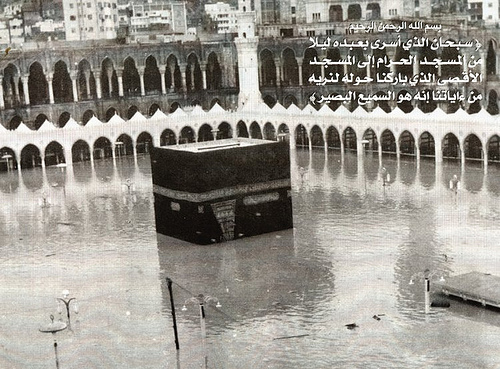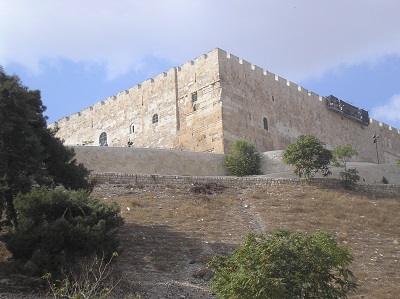"Rain falls rarely, but it is tropical its violence, and does considerable damage to the town. On these occasions, during an inundation (seil), the mosque is often flooded to a depth of several feet, .......
And we know that urban floodwater is always laced with human sewage! What a foolish site the Quraish pagans chose on which to build their Kaaba eigh? With that kind of engineering it's no surprise they didn't even get any two sides to come out the same length!

Unlike the one true God that had his His people build His temple on a mount on a hill, thousands of years before the Quraish pagans built their kaaba in Mecca:
Exo 25:8
And let them make me a sanctuary; that I may dwell among them. 9 According to all that I shew thee, after the pattern of the tabernacle, and the pattern of all the instruments thereof, even so shall ye make it.https://www.blueletterbible.org/kjv/exo/25/1/s_75001The mount of which still stands today:

Eventually God arranged to have that temple torn down - every stone as prophesied by Jesus - after Jesus built our Christian-era temple in 3 days:
http://www.beholdthebeast.com/temple_of_god.htm....... since it lies lower than the surrounding city, whose level has been gradually raised by debris accumulate through the destruction and rebuilding of the houses." (Handbook of Hejaz. Cairo: Arab Bureau, 2nd edn, 1917. p. 30)
When the summers got too hot, the Meccans used to leave Mecca to stay at Al-Taif in order to avoid the blazing sun. "It [Taif] is much cooler than Mecca, and has a plentiful water supply. Both in climate and physical character the district resembles the highlands of Asir and Yemen, the monsoon or tropical rains, which are unknown elsewhere in elsewhere in. Hejaz, falling heavily in the early autumn. Water is obtained from abundant springs and brooks, the principal stream, the Seil, being beautifully clear but lukewarm." (Handbook of Hejaz. Cairo: Arab Bureau, 2nd edn, 1917. p. 32)
Sure they did, in order "to avoid the blazing sun". There's some classical Islamic taqiyyah for all to appreciate! Can't even you see how Islam's dissimulators dupe the people that trust them?
The fact of the matter is that the Quraish went on Hajj to Taif because it was an older, more established and far more significant place of pagan worship than Mecca, and the Quraish continued to go on Hajj there, long after the Quraish built their Kaaba in Mecca, which is why Muhammad tried to talk them out of it:
Surah Quraish 106:1-3
For the covenants by the Quraish, their covenant journeys by winter and summer, let them adore the lord of this house."The Kaabah of Mecca was one of many Kaabahs that were branches of the Kaabah of Taif; It was of the same building style and had the same religious pagan functions.
Islam is a form of the Arabian Star Family worship of Mohammed’s time. The veil which tries to hide this reality falls when we study the roots of the Islamic religion.
Ibn Abbas, the cousin of Mohammed, and one of the reporters of the tradition of Mohammed, called Hadith, speaks of two pilgrimages of the Quraish tribe. One of the journeys was to the city of Taif.[i [1]
At Taif there was also a temple called Kaabah of Ellat, or Kaabah of the Sun. This Kaabah was more significant and much older than the Kaabah of Mecca. All Arabs, including the tribe of Quraish from which Mohammed came, venerated this Kaabah. The Kaabah of Taif was identical to the Kaabah of Mecca, and it had the same religious functions. Like the Kaabah at Mecca, it had a sacred valley where no animals or humans were allowed to be killed. The Kaabah of Taif had the same Sidaneh, or religious rituals, adopted by the Kaabah at Mecca. The Kaabah of Taif also had the Istar استار , a kind of dress to cover the sacred stones like we find at the Kaabah of Mecca. Both the Kaabah of Taif and the Kaabah of Mecca had a yard, or an area, which was inviolable. No one could cut its trees or hunt its animals. Anyone who entered there for refuge was protected. Both Kaabahs also had a well in which to put gifts.[ii] [2]"
http://www.islamchristianforum.com/index.php?topic=1140.0https://en.wikipedia.org/wiki/Al-LatAlso:
"Despite the general aridity there is probably no spot in Arabia which does not now and then receive a light shower or at long intervals a heavy storm. When these occur the steppes and deserts, except in limited areas where the white quartz sand may be chemically sterile, respond at once, especially in spring. with a luscious growth of herbage affording valuable pasture for camels, horses, and sheep." (Western Arabia and the Red Sea, p. 178).
Additionally, the Christian "scholars" that you've cited are either disingenuous or uninformed about the existence of early literature that describe ancient pilgrim stopping places in Arabia that had abundant water supplies.
Not at all, including actual places like Mada'in Saleh, al-Ula and Dedan, for example, there are the ruins of actual ancient temples and where the qibla of the oldest mosques would seem to point.
http://www.petewaldo.com/oldest_mosque_qibla.htmRafat Amari, for instance, conveniently cites Muslim historians in his website as if they validate his own arguments (which they really don't) and yet he ignores so many Muslim historians who documented fertile areas on the way to Mecca which the pilgrims used to stop by.
But that's false. They recognize, for example, that Median was established in as early as the 6th century BC as the overland route along the Red Sea began to be established (over 1,000 years after Abraham).
Here are just some them:
Wadi Fatimah:
"It is situated about 20 km north-west of the holy city of Makka on about 21°37'N and about 39°41'E. This pilgrim station is considered to be a large pilgrim halt and is very important because it is close to the holy city of Makka and has to provide for the needs of the pilgrims and their animals. [...] In addition to the pilgrim station, Wadi (valley) Fatimah, is considered to be one of the largest and most fertile wadis in the western province (Hijaz) in Saudi Arabia. It had abundant water resources such as springs, wells, water-tanks, canals, cisterns and basins. Unfortunately, most of these water resources have been destroyed, either by natural factors such as winds, floods and dry weather or by human factors such as ploughing the arable land around the water resources, particularly where the canals, basins and water-tanks are situated."
Asfan:
"Yaqut (1955, vol 4, p. 121-122) described Asfan as a village and watering place with farms and palm groves on the road between Medinah and Makka. Ibn Batutah (N.D. p. 148) refers to Asfan as flat land between mountains with wells and springs. Al-Harbi (1981 p. 465) says Asfan possesses many wells, springs and water tanks. Al-Biladi (1985, pp. 29-35) describes Asfan as an ancient town 80km from Marra and the second stop from Marra on the caravan route. It consists of a number of wells. The halting place has major water resources which include a birkah (water-tank), a number of abyar (wells) and qanats (canals)."
Al-Safra:
"Al-Safra described as a village supplied by springs and with farms and palm groves (Arram N.D. p.9) is a wadi valley with several tributaries, it extends for more than 50km and runs from the north-east roughly towards the south-west. Al Isfahani (1968, p. 410) describes Al-Safra as a wadi with many palm-trees, about two nights journey from Medinah. Al-Himyari 1975, p. 362 describes Al-Safra as a village six day's journey from Medinah. It consists of plenty of springs, farms and palmgroves. Unfortunately most of these villages are now in ruins and only a few people remain."
Wadi Waddan:
"One example of these way stations that once existed and have now disappeared is Waddan. This way station was mentioned by the early Islamic geographers and travellers as an important pilgrim station where water is abundant."
AI-Suqya:
"According to Ibn Khurdadhabah (1889 p. 130) it lies on the conventional pilgrim route between Medinah and Makka. He locates it at 36 miles south of AI-Ruwaithah and 29 miles north of Al-Ahwa towards Makka. He says it possesses a flowing river. Qudamah (1889 p. 157) follows him exactly to the letter, but he adds it has an abundance of trees. [...] AI-Bakri (1983, Vol., 3, pp. 742, 743) describes AI-Suqya as a principal village which lies on the conventional pilgrim route between Makka and Medinah."
Source: The Water Resources Structures on the Syrian and Egyptian Pilgrim Routes to Makka and Medinah
Furthermore, springs are still common in the mountainous areas of the Hijaz:
"In the absence of permanent rivers or bodies of water, streams, groundwater, desalinated seawater, and very scarce surface water must supply the country's needs. In eastern Arabia and in the Jabal Tuwayq, artesian wells and springs are plentiful. In Al Ahsa a number of large, deep pools are constantly replenished by artesian springs as a result of underground water from the eastern watershed of the Jabal Tuwayq. Such springs and wells permit extensive irrigation in local oases. In the Hijaz, wells are abundant, and springs are common in the mountainous areas."
https://en.wikipedia.org/wiki/Geography_of_Saudi_Arabia#Water_resources
Nobody is arguing that overland travel became possible along the Red Sea by about the 8th-6th century BC (over 1,000 years after Abraham) and of course associated development resulted over the ensuing years. Indeed even Medina is an ancient town, that was settled in about the 6th century BC. However prior to that time spices and other goods from Yemen were moved up the Red Sea by boat. It wasn't until piracy became such an issue that men sought to travel overland through the harsh, dangerous and uninhabitable terrain.
As you list the evidence of other towns that may predate Mecca, you don't seem to understand that you are further condemning Mecca as having no early history. Look at the evidence in the Islamic Museum in Mecca.
https://ne3matullah.wordpress.com/2010/07/03/islamic-museum-in-makkah/Or try the National Museum of Saudi Arabia's page on the pre-Islamic era. We find discussion of older habitation in northern Arabia, in the Yemen area, and Riyadh - but still no Mecca:
http://nationalmuseum.org.sa/preislamicera.aspxIf Mecca were an actual ancient town, when the foundation of a new building or house was excavated, or someone even just planted a tree in their yard (if anything can even grow there without irrigation), ancient artifacts and pottery shards and such would have been uncovered. Just like in
THE Holy Land of the prophets and patriarchs. Disturbing the earth through expansion on the outskirts of Mecca, should uncover a treasure trove of stuff - if as you are taught,
Mecca had been the center of civilization since Adam! Yet everything in their museum dates from the 7th century forward.
Like the recently discovered artifacts in a tomb dated to the 1st century from up in NE Arabia, which would be within the general vicinity of part of the range in which the scriptures indicate
the Ishmaelites actually ranged (and part of the ancient trade route they controlled):
http://beforeitsnews.com/strange/2012/11/mysterious-ancient-artifacts-discovered-in-saudi-desert-legendary-city-of-gerrha-found-2445510.html